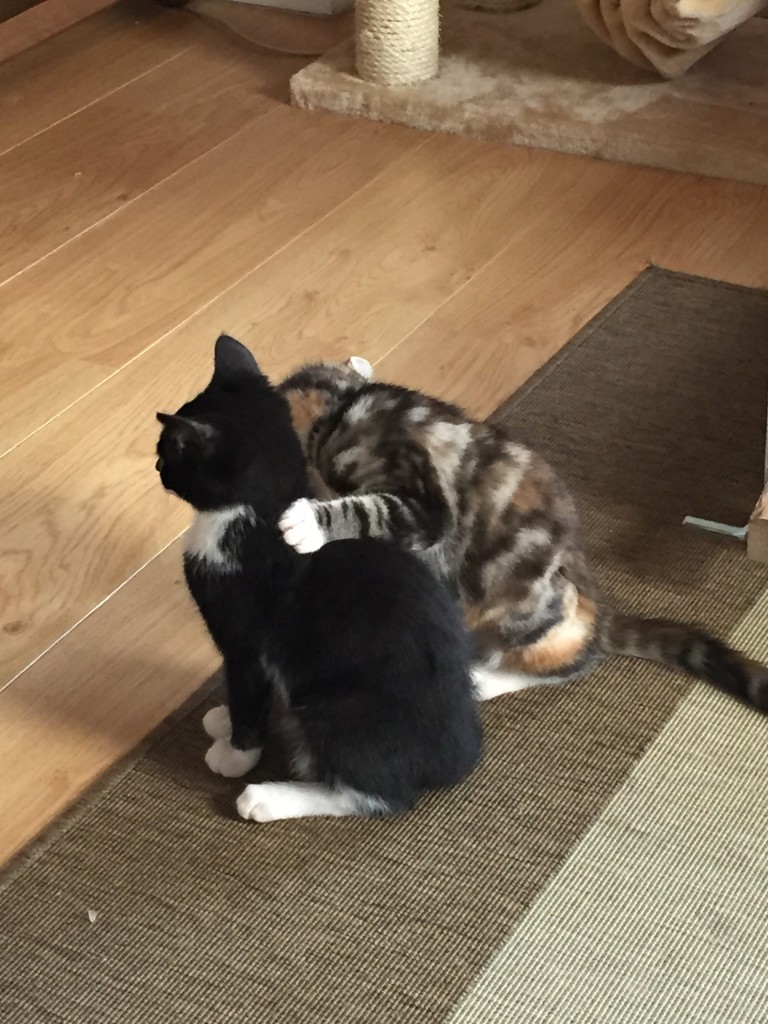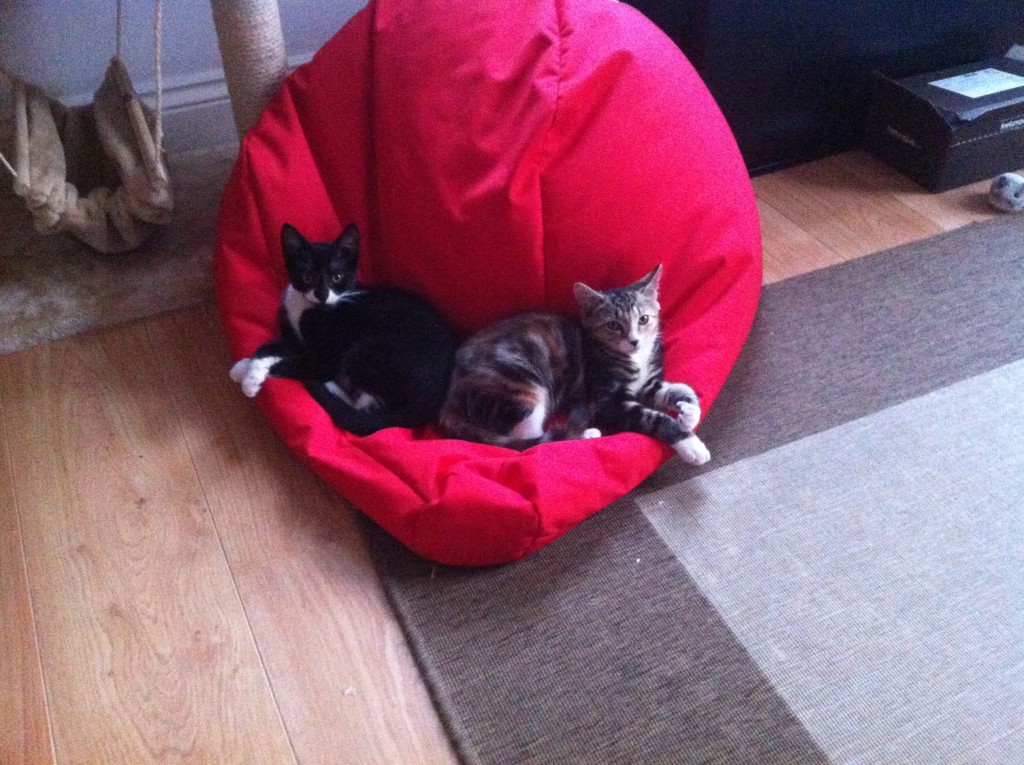Cleaning after your pets the natural way by Daiga Miezite
Daiga Miezite, has a masters degree in Humanities from the University of Latvia in Classical studies (language, literature and history of Ancient Greece and Ancient Rome), and built a successful career in sales and marketing before deciding she needed a change and moving to London. When an offer came through to compile material for a book on environmentally friendly, natural cleaning, she jumped at the chance. Having grown up in the country, her granny’s cleaning recipes were her first solutions and back then, taking care of the environment you live in, was just normal practice. So when green living got trendy and she had access to even more information and eco- friendly ways of living, she continued her research and testing. While she was working on the book she realised that this was her passion and started experimenting with the knowlege she had gathered over the years. Four years on, she says she continues to be amazed by simple household items that can be used to great effect, the power of natural resources and how simple and chemical free our lives could be. Having published the book and moved on, she now has her own experience and opinions, her own tips and tricks all of which she is ready to share.
Living in harmony with cats
After two years of persuasion, my boyfriend got his way and we now share our home with two little rescue kittens. Mika, also known as Bandita, and Moustache, also known as Hoover.
Mika got her nickname as she is the one who digs out my potted plants, hangs on curtains, pulls off anything that is hanging anywhere from chair backs to laundry hangers and sleeps on top of whatever she has ‘acquired’. She will eat any plant within her reach, play with the toilet brush, even take a nibble out of the candles I make. She is into anything and everything around. Her last achievement – munching off the pompoms of my jumper and hissing when I tried to get them back.
Moustache is mainly interested in food and wolfs it down better than any vacuum cleaner sucking up dust. After the initial shock of having most of my things ruined and asking my boy friend to choose between “myself and the kittens” (which didn’t really work because he chose the kittens, obviously!!), I decided to try another tactic: living in harmony and guiding the little rascals off my precious stuff. After all, at the end of the day, when they are happy and purr loudly in satisfaction (and are not under my bed in the middle of night, waking me up), I do secretly love them too.
But something had to be done and I started looking for an eco-solution that would serve us both well!
Saving indoor and outdoor plants
The first thing I started with, was my plants. Some things that worked for me are as follows:
Sprinkle some Cayenne chilli pepper on soil. This works although the soil does get a bit mouldy where the pepper is. The little rascals haven’t touch my plants since then even though time after time they do come to check up.
For mouldy soil, it would help if you scrape it off as much as possible without harming the roots and then pour some diluted backing soda, to neutralise soil acidity.
There is also the option of putting some decorative gravel or rocks on top of the soil. This also helps stop pets from using plants as a litter box.
The above works for indoor plants, however, it is quite a tough job to keep pets out of flower beds as well.
The below should dissuade cats from using flower beds as litter boxes.
Mix ½ cup of baking soda, 3 tablespoons of dry mustard and 1 tablespoon of powdered cayenne chilli pepper. Combine all ingredients and sprinkle on the borders of your flower beds. You may need to reapply mixture after rain.
Another option is to put some citrus fruit peels on the soil around plants. This is useful also for indoor, potted plans and would also be an alternative to cayenne pepper.
You can also plant some lemongrass. In India it is used it as tiger repellent, so it should work for little domesticated tigers as well.
You could also try planting lavender, sprinkling some pine cones or using a predator’s urine(though am guessing this won’t be as easily accessible or pleasant).
Saving clothes, fabrics and soft furnishings from tiny claws
It is quite heartbreaking to observe how quickly your furniture could get scratched by tiny claws and blissful faces. We bought every toy including scratching posts to dissuade them from exercising their nails on the furniture, all of which they really enjoy, but none of which stopped them scratching the furniture. Time after time, more often than I would like, they clawed our sofas anyway. Sofa covers only encouraged more hide and seek type games on the sofa which usually ended with the cover on the floor and the kittens clawing the sofa.
Essential oils
I opted for essential oils. Knowing that a good essential oil does not stain fabrics (vegetable oils and certain forms of carrier oils do though) and cats do not like smell of citrus, I rubbed some orange essential oil onto my sofa. Before applying oil though I would suggest you test it on an inconspicuous area of your sofa just to be doubly sure that it will not stain an expensive fabric. Alternatively, you could apply a few drops of essential oil onto a clean cloth and rub the areas of the sofa where little nails seem to make a bee line to. Unfortunately though, oils evaporate and you will need to reapply them after around 2-4 days, but that’s the only inconvenience to my mind.
Citrus peels around the legs of the furniture also may help, but citrus peels scattered on the floor or the carpet am guessing won’t be an attractive option for anyone, not even for training purposes.
Double sided tape on open parts of furniture will also help as cats do not like sticky things.
To save your clothes that may be pulled out of a carelessly shut wardrobe door that little paws could possibly open, I suggest putting some pieces of cloth with a few drops of citrus essential oils on shelves and on top of the clothes and try to keep your pets out of your wardrobe during the night and while you are away.
Another option is to mix some water with few drops of citrus essential oil and spray it on fabric covered furniture and/or inside your wardrobe. Since the mixture is diluted, you will need to spray it more often.
Caution
Essential oils are extremely concentrated liquids so please be careful when dealing with them and always wear gloves. Firstly, because undiluted oil can burn your skin and secondly, it is aromatherapy – an oil which impacts on you through aromas as well.
If you are pregnant or planning to have baby I would suggest to avoid using them at all unless you are a very experienced user or a professional, but even then, it is recommended that you avoid them for at least the first trimester and be extremely careful with them during the course of the rest of your pregnancy.
The Litter box
The smell from the litter box can be quite daunting. Spraying shop bought air fresheners was out of question as to me they smelled too artificial. I do not like them, as I have no idea they are made of and I would not want to spray anything that would harm the little ones. With time though, as it happens, my nose became accustomed to the smell. However, when guests, started trying obviously but politely to ignore the smell and neighbours, started spraying air freshener around the stairway, this made me think about a way to eliminate the odour naturally.
First of all – plain baking soda. It’s non-toxic and works well to eliminate odours in general. I use it sometimes in my fridge as well or mix it with some lavender and sprinkle on my carpets and vacuum to refresh carpets and the home. So, when you clean the litter box, sprinkle some baking soda under the litter and mix it in the litter or sprinkle it on top. You can use it as often as want. It will help to eliminate litter smells.
You can also add some drops of essential oils. Pour one cup of baking soda and add 10 drops of essential oil or oil mix of your choice into a plastic bag, mix it well and let sit overnight to absorb essential oil or mixture of oils, and sprinkle mixture over the litter whenever you feel it is necessary. Kittens do not seem to mind it at all so will still use their litter box. I wouldn’t suggest including citrus essential oils though as this may dissuade them from using the litter box nor should you use other harsh fragrance oils in the mixture as if you do not know what the origin of fragrance oils are and you would not want to harm your pet.
The other thing you can use, is vinegar (one of my favourite cleaning products). It also helps to eliminate odours, is antibacterial and friendly to kitties. Wipe the litter box clean with it, before adding the litter and make an odour fighting spray. You can mix one part of water with one part of white vinegar and some drops of essential oil or essential oil mix of your choice. Gently shake and spritz it over the litter whenever it gets too smelly.
You can use also some herbs like lavender, peppermint, spearmint or lemon-balm. Grind them into a powder and add some baking soda or corn starch which also eliminates odours very well. Sprinkle the mixture over the litter whenever your nose signals that you need to.
Cleaning up the mess
Accidents happen, be it during litter training (usually cats don’t need training, but ours, when we brought them in at first, decided to use a fluffy towel which was supposed to be used as bedding, to pee on, instead of using their litter box), be it the cat’s health issues (for older cats), be it marking their territory or throwing up hairballs. In any case it is very unpleasant and not so easy to get rid of. Below are a few tips you could think about using.
Urine
This is the smelliest and worst of it all. Not only because of the smell and the stain but because even after you clean it, you have to be very sure that your cat is not attracted to the same spot again and again.
More or less all green/natural cleaning involve 4 ingredients for cleaning up the mess. i.e. water, white vinegar (please note, for cleaning it is always, always only white distilled vinegar and never malt vinegar as it is milder and malt vinegar tends to stain), baking soda and household strength (3%) hydrogen peroxide. You can mix them all up or use a combination of some of them (usually you would use either vinegar or hydrogen peroxide not both). Whenever you use hydrogen peroxide, use it from its original bottle and also any leftovers cleaning concoction that has included hydrogen peroxide in the mix should be discarded.
If you can smell the cat’s urine but cannot find the spot, it probably means that the cat marked the spot some time ago and the urine has dried out and is invisible to the eye unless there is a stain. The only one way to find marked such marked spots by the way, is to use a black/UV Led light.
If the spot is still wet, blot it with a paper towel and get all the liquid off before starting to clean it.
The other thing to remember is, that before applying any cleaning stuff on furniture, upholstery or walls, try it in some inconspicuous area just to be on the safe side and to make sure you do not end up with even bigger stains.
Then use either a water and vinegar mixture (you can start with ¼ cup of vinegar in ¾ cups of water and go up to 1cup of vinegar in 1 cup of water) or make a cleaning solution consisting of 1 teaspoon of baking soda, 1 tablespoon of vinegar and 2 cups of water and spray over the stained area. Wipe it off with sponge if it is on hard surface or dab in properly with your fingers or sponge if it is on the carpet or upholstery. Again blot off all excess liquid with a paper towel and let the surface dry. You can also add a bit of dishwashing liquid to a cleaning solution as well, but remember that it should not be more than ½ a teaspoon. You can also add some drops of essential oils.
Another way to clean a cat’s urine is with baking soda which absorbs the smell. Sprinkle it generously on the offending area, work it in with your fingers or a clean sponge (taking care not to damage the area), let it dry and absorb odours and after a few hours, vacuum it away. You may also sprinkle some baking soda on the offending area and pour some hydrogen-peroxide on top (if it is not a carpet as hydrogen peroxide and vinegar may bleach). It will fizz quite fiercely which is normal, so don’t worry. Work it onto the stained area with a sponge or your fingers, let it dry and then vacuum it up.
It is also suggested that you use a vinegar/water solution for dried urine stains but avoid using vinegar on any wet stains. It is better to substitute a water and hydrogen peroxide mixture as it cleans urine away without further acidification, preventing residual odours.
If the vinegar / hydrogen-peroxide or water spray does not take out all of the stain and smell, you can put a baking soda and water paste on the stain as well and let it work a miracle.
After cleaning the washable items such as blankets or curtains put them in washing machine, adding 1 or 2 cups of baking soda (depending on the size of your washing load) to your regular laundry detergent and you could also add 1 cup of white vinegar and run your items through 2 washing cycles and dry them outside in the sun to prevent locking in, any remaining odours with the heat of the dryer.
After cleaning use a black light again to check if the stain is really gone. If not, repeat the cleaning process to ensure that it is completely clean.
Vomit
Throwing up hairballs or some excess food makes another nasty stain you might want to get rid of.
Start with wiping or scraping off as much of the vomit as you can but take care not to squash it into the carpet or soft furnishings.
You can use any of the urine stain cleaning recipes or try something different, with a few changes. First, spray the affected area with cold water and blot it off with clean paper towel.
Dissolve 1 tablespoon of table salt in 2 cups of warm water. Add ½ cup of vinegar, 1 tablespoon of dishwashing liquid and 2 table spoons of alcohol. Dip a clean sponge in a solution and work over the affected area cleaning away the rest of the vomit and the stain.
After you are done, sprinkle some baking soda on the stained area to remove any unpleasant odours, let it sit for some hours and then vacuum it away.
Alternatively, after cleaning up as much of the vomit as you can, spray on some warm water and vinegar mixture (5:1) on the stain, dab it with a paper towel or a clean cloth and sprinkle some baking soda on top. Let it sit for a while and dampen the stained area again with a water and vinegar spray and dab it again. Repeat the process until the stain has faded or disappeared.
Hairballs
Hairballs are a natural result of your cats grooming – hair which collects in the stomach of the cat as the result of the animal licking its coat. They are not only unpleasant surprises to find around your home but can be bad for your pet’s health and can lead to potentially serious intestinal blockages.
There are several ways of getting rid of them but I, as usual, prefer prevention over cure or rather prevention over dealing with the consequences.
First of all – brushing! It can be a nice bonding experience with your cat and it helps to maintain a clean coat, it prevents matted fur forming and also reduces the amount of hair the cat swallows during self-grooming. Just find the best brush or comb that your cat has a preference for and you can both enjoy the process.
The frequency of brushing needed, depends on the length of fur of the cat– the longer the hair, the more often it needs to be brushed. Cats with short fur coats can be brushed once a week compared to long haired cats who need to be brushed at least once a day. The frequency also depends on your cat’s ability to groom him/herself, the amount the cat is shedding which varies throughout the year and also the cat’s tolerance to grooming.
After brushing, especially if it was static-filled one, run a slightly damp paper towel over your cats coat to pick up any remaining loose hair.
The other way to prevent or at least lessen the creating of hairballs and endangering your pet’s life and health, helping your cat to get them out one way or another is grass. There is no clear answer why cats eat grass. It might be because and cat food is generally protein based and does not contain much fibre and the grass contains fibre. A cat’s stomach does not have the enzymes needed to digest it, but it helps cats to get rid of undigested matters like hair and bones if your cat is feral. So do not prevent your cat of nibbling grass outdoors. You can even buy some grass as a treat for your indoor cats as well.
We have a patch of grass and our cats adore it. The most difficult part was growing the grass as our little furballs managed to find the tray with grass no matter where I hid it and tried to pluck it out as soon as it started to germinate.
Fleas
Fighting off fleas is another area in which your feline friend will need your active help and natural prevention methods like regular vacuuming, washing their bedding etc might not be enough.
As for cats, self-grooming involves licking their coat a lot, using of essential oils might not be as good and safe an idea as it is for dogs. The other thing is whatever you try, you need to observe your cat to see if the smell is too strong or not as they have very sensitive noses. They might not like citrus or certain herb smells so you will need to go for another flea treatment option.
It turns out that fleas are very sensitive to the smells like citrus, certain herbs or vinegar, even more so than your cat.
What you could do, is to try to make one of these water infusions and use it as flea repellant.
Take 2 cups of rosemary and add 2 pints of water to it (a bit more than 1 litre). Boil for 30 minutes, strain and mix it up with 1 gallon of water (around 4.5l). Spray it generously onto your pet and let it air dry.
Chop up 3 lemons and add the lemons to 3 cups of water. Bring it to the boil and take off the heat, leaving the lemons steep in water for 3 hours. Strain it, pour, the clean liquid into spray bottles and it is ready for use. Spray the liquid on your cat or cat’s bedding or onto areas where you suspect fleas may be hiding out, if your furballs do not mind the citrus smell.
Infusions generally are less concentrated than essential oils and even if your cat does not like the smell of essential oil itself, it does not necessarily mean that is the same with infusion.
After spraying your cat with the infused liquid you can use also use a flea comb to get rid of fleas, eggs and other stages of the flea’s development.
You can also spray your pet with a white vinegar and water mixture (1/4:3/4) or undiluted apple cider vinegar as well or add it to the cat’s bath if you wash your cat.
I hope this has all helped somewhat with how to keep your cats and house clean and free from unwelcome smells and stains.
If you would like more information please feel free to email me at [email protected]





























